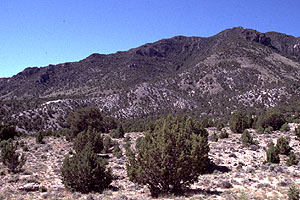

Western Utah is the home of one of the best-known Cambrian fossil localities in the world. The slopes of Swasey Peak in the House Range, seen above, are composed of a rock layer known as the Wheeler Shale, with the overlying Marjum Formation forming the top of the peak. The Wheeler Shale and Marjum Formation, strata of Middle Cambrian age, are exposed throughout the House Range and nearby mountain ranges west of the town of Delta, Utah. The Wheeler Shale is named for a great bowl-shaped feature in the House Range known as the Wheeler Amphitheater, while the Marjum Formation is named for its outcrops at Marjum Pass, also in the House Range. Much of the Wheeler Shale is quite unfossiliferous, but certain layers contain abundant trilobites and other shelly fossils. The Wheeler Shale and Marjum Formation also contain a diverse biota of soft-bodied fossils, including many of the same taxa found in the more famous Burgess Shale.

In the Cambrian, the continent of Laurentia, which now makes up the majority of North America, lay close to the equator. Laurentia was rotated about ninety degrees from its current position, and the equator ran through what is now western North America. The actual position of the shoreline varied with time, but in general, it ran through Utah in what is now a north-south direction, before turning southwest and crossing into southern Nevada. However, in the middle Middle Cambrian, the ocean entered central Utah by way of a broad bay, the House Embayment. Close to the shorelines of Laurentia, limestone was deposited in the warm shallow waters. Beyond the shallow-water limestone belt, fine sediments accumulated in deeper water offshore, sometimes accumulating rapidly when undersea landslides dropped large amounts of sediment off the carbonate platform. These offshore deposits along the paleoequator include much of the Wheeler Shale, the Burgess Shale of western Canada, and other sites from California through Utah to the Northwest territories of Canada. All of these sites have yielded remarkably preserved Cambrian fossils, in large part due to rapid burial.
ALGAE:

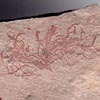
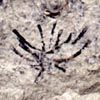
Non-mineralized algae are well represented in the Wheeler Shale. Among the most common fossils in the Wheeler Shale are dark irregular patches (above left). These fossils, known as Morania fragmenta, show little detail but are thought to represent colonies of cyanobacteria. Some living cyanobacteria, notably the genus Nostoc, form colonies of a similar shape. Also abundant at several sites are bundled filamentous organisms named Marpolia spissa, which are also considered to be cyanobacterial in origin (above center; actual size about 1 cm). Some specimens of both genera are sufficiently well preserved that the arrangement of individual cells can be seen under the microscope, supporting the identification of both of these genera as cyanobacteria. Several genera of eukaryotic algae are also present in the Wheeler Shale. Yuknessia, shown above right, is thought to be a green alga, although in the absence of preserved pigments this is not really certain. Other probable green algal genera are also present. It is interesting to note that almost all of the algae of the Wheeler Shale, including all of the species depicted here, are also present in the Burgess Shale. Besides macroscopic algae, the Wheeler Shale has yielded a few microfossils: acritarchs and radiolarians.
TRILOBITES:
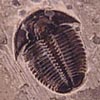
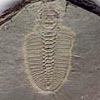
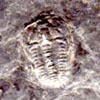
The most famous Wheeler Shale fossil is the trilobite Elrathia kingi, shown at the upper left. Elrathia is so common at some sites that specimens are commercially quarried and are made into bolo ties, earrings, and belt buckles, as well as being sold to collectors and institutions all over the world. However, Elrathia is just one of about fifteen trilobite genera that have been found in the Wheeler Shale. Bathyuriscus fimbriatus (top center) is also relatively common at certain sites. This specimen looks a bit odd because it, like most specimens from the Wheeler Shale, is missing its "free cheeks", semicircular portions of the head that broke away during molting. A locality near Swasey Peak has yielded small trilobites (less than 1 cm) not commonly found anywhere else, such as Brachyaspidion microps (top right). These "dwarf species" are commonly found with abundant Morania, unlike most other trilobites; this may suggest that the small size of these species was an adaptation for living in particular physical or chemical conditions.
Even more abundant are several species of agnostid trilobites, depicted on the lower row. These are rarely if ever longer than a centimeter in length, and are also found in association with Morania. Ptychagnostus is shown above at lower left, from a site near Swasey Peak. The very similar Peronopsis is shown to its right. Agnostids may have been planktonic, but some paleontologists have reconstructed them as nektobenthonic -- that is, as living in the water just above the bottom.
OTHER INVERTEBRATES:
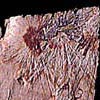
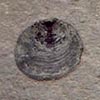
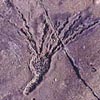

The uper row shows four more of the mineralized fossils found in the Wheeler Shale. More than twenty species of sponge have been found in the Wheeler Shale and Marjum Limestone. Choia, at upper left, is a sponge with long, needlelike spicules, rather resembling a squashed pincushion in life; it is also present in the Burgess Shale. Acrothele is a fairly common inarticulate brachiopod in the Acrotretida. The two remaining fossils are both echinoderms. Gogia is an eocrinoid, a member of a grouping of early echinoderms that probably included the ancestors of true crinoids and other echinoderm taxa. Castericystis, from the Marjum Formation, is a homalozoan, a member of a small extinct group whose members were asymmetrical or bilaterally symmetrical.
The lower row shows two examples of soft-bodied fossils from the Wheeler Shale. Perspicaris at the left is the carapace of an arthropod that was probably related to the Crustacea. The body within the carapace was segmented, but it is not certain whether the tail protruded from the rear of the carapace, which would make the living organism somewhat resemble a modern shrimp. A number of arthropod carapaces like Perspicaris are known, but most lack traces of the anatomy of the animal inside them, and thus their exact relationships are not certain. Selkirkia, on the right, is an unmineralized conical tube, preserved as a flattened film on the rocks. This specimen, less than two centimeters long, is from the Wheeler Shale of the Drum Mountains, close to the House Range. Rare specimens of Selkirkia preserve the remains of the animal that once made and lived in the tube: a priapulid worm. Over twenty species of non-mineralized arthropods have been found in the Wheeler Shale, as well as annelids, priapulids, and other worms, and the swimming predator Anomalocaris. And new discoveries continue to be made at this locality.
For more information about Utah in the Cambrian:


